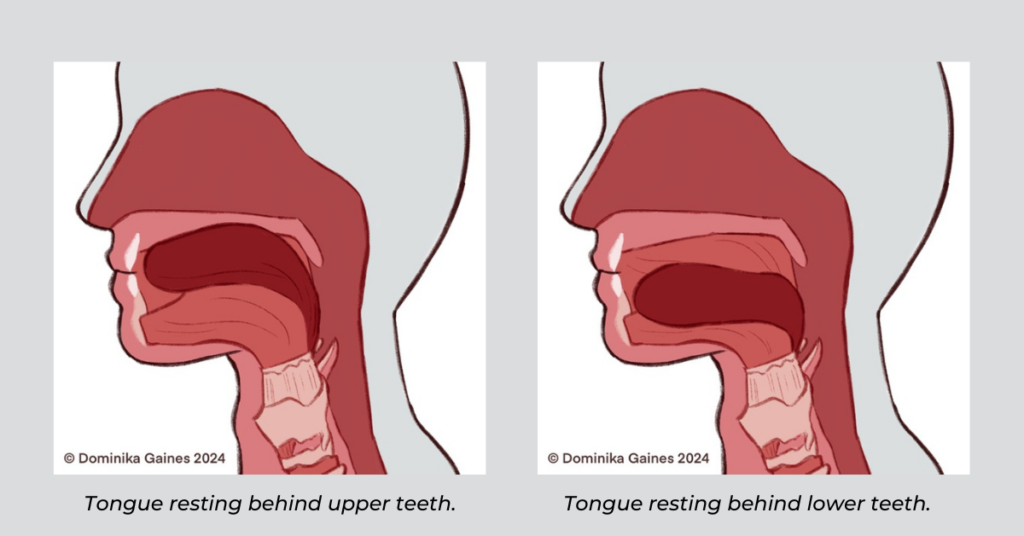
The Hidden Habit: Proper Tongue Posture
Most people let tongue position happen by habit. Where your tongue rests can influence nasal breathing, swallowing mechanics, jaw comfort, and snoring. The goal is not a single perfect position for everyone. The goal is to match posture to your needs and test what improves comfort, airflow, and symptoms.
Why tongue position matters
Airflow, pressure, and muscle tone shift when the tongue rests against the palate. A higher tongue can help support the upper airway and encourage nasal breathing, which lowers the chance that the soft palate and tongue fall backward during rest or sleep. Imaging and orthodontic studies link tongue posture with airway size and craniofacial patterns, especially in growing children (Iwasaki et al. 2013).
Nasal breathing adds another advantage. The nose warms and filters air and delivers nitric oxide from the nasal and sinus passages. This compound contributes to vascular regulation and host defense. Brief humming through the nose increases sinus ventilation and transiently increases nasal nitric oxide levels, which explains why quiet humming can feel clearing for some people.
Chronic mouth breathing tells a different story. Reviews associate it with narrower dental arches, altered facial growth patterns, dry mouth, and higher risk of dental disease. Treating the cause of mouth breathing and retraining daily tongue posture can support prevention and care over time.
Therapy that strengthens and coordinates tongue and orofacial muscles can reduce symptoms in people with snoring or mild obstructive sleep apnea. Systematic reviews and clinical trials report improvements in apnea severity and daytime sleepiness when myofunctional exercises are added to standard care for selected patients (Rueda et al. 2020).

The short guide
If your goal is quieter sleep
Practice a tongue up rest position during the day and favor nasal breathing. At night try a side posture rather than lying flat on the back. Many people snore less when the tongue and soft palate are less likely to collapse backward. Add simple orofacial drills that train a gentle seal of the tongue to the palate (Camacho et al. 2015).
If you struggle with mouth dryness or bad breath
Keep lips together and maintain a tongue to palate rest position. Support nasal hygiene with a saline rinse and consider brief humming to ventilate the sinuses. This keeps air humidified and supports nasal nitric oxide delivery
If you are a parent watching a developing smile
Notice habitual mouth open posture, snoring, or difficulty with nasal breathing. Discuss these signs with a clinician. Early attention to airway, tonsils, and tongue posture can support healthier growth patterns during development
If you have heartburn with night symptoms
Limit air swallowing by favoring a closed mouth and nasal breathing routine, especially when combined with other reflux strategies such as earlier dinners and head-of-bed elevation. Seek clinical guidance if symptoms persist since reflux management is multifactorial (de Menezes et al. 2022).
What proper tongue posture looks like
At rest the whole tongue gently contacts the roof of the mouth. The tip sits on the ridge just behind the top front teeth without pushing. Lips are together. Teeth are slightly apart. Air moves in and out through the nose. Think of this as a quiet default you can return to throughout the day.
Why a higher tongue can help the airway
When the tongue is low, the upper airway behind the tongue can narrow. When the tongue rests up and forward against the palate, the oral cavity becomes smaller and the tongue sits a bit more forward. Orthodontic imaging shows that interventions that lift the tongue and expand the palate can accompany increases in airway volume in selected patients. Mechanism and effect size vary, so personal testing and clinical evaluation matter (Iwasaki et al. 2013).
How to test your best position
- Pick a primary goal such as easier nasal breathing, less snoring, or fewer dry mouth awakenings.
- Learn the rest position. Place the tongue on the palate with the tip on the ridge behind the top teeth. Close lips. Breathe through the nose.
- Practice three times daily for one minute. Add five slow nasal breaths each time.
- Log nightly symptoms for one to two weeks. Note snoring reports, awakenings, mouth dryness, and morning energy.
- Adjust one element at a time. Try a side sleep posture, a nasal rinse before bed, or a longer daytime drill.
- Reassess. Keep what helps and drop what does not. Seek clinical evaluation for significant symptoms.

Practical tips
Cues that help
Place a small note on your monitor. Set a phone reminder. Pair a tongue posture check with red lights, emails, or brushing your teeth.
Drills that work
Press the whole tongue to the palate for five seconds and relax for five seconds. Repeat ten times. Create a gentle suction seal that lifts the tongue and hold for fifteen to twenty seconds. Repeat five times. Hum softly through the nose for about one minute to ventilate the sinuses before sleep or exercise (Lundberg and Weitzberg 2003).
Habits that multiply the benefits
Keep nasal passages clear with saline and sensible allergy care. Maintain ears over shoulders and a relaxed jaw when using screens. Chew thoroughly and swallow with the tongue moving up and back rather than forward against the teeth. Reviews connect these everyday mechanics with healthier oral and airway function over time.
Common pitfalls
Pressing the tongue tip against the front teeth creates pressure and can worsen alignment over time. Aim for a light seal on the palate instead.
Clenching is not required. The jaw should feel relaxed and the teeth should not be pressed together at rest.
Forcing nasal breathing when congested is uncomfortable. Clear the nose first and seek care for persistent blockage or suspected sleep apnea.
When to seek care
Talk to a clinician if you have nightly snoring with pauses in breathing, daytime sleepiness, frequent nasal blockage, or dental crowding that worsens. Positional strategies and exercises are helpful, but ongoing sleep disordered breathing, chronic rhinosinusitis, and malocclusion deserve proper diagnosis and treatment.
The takeaway
For calmer breathing and quieter nights, train a tongue to palate rest position and prefer nasal breathing. Use short practice sessions during the day, add simple drills, and combine with supportive sleep posture. If symptoms are significant or persistent, involve a qualified clinician. Small position changes are easy to test and can improve comfort for many people (Camacho et al. 2015).
References
Alving K, Weitzberg E, Lundberg JM. 1993 Increased amount of nitric oxide in exhaled air. European Respiratory Journal 6 126–130.
Camacho M, Certal V, Abdullateef U, et al. 2015 Myofunctional therapy to treat obstructive sleep apnea. Sleep 38 669–675.
de Menezes VA, Leal RB, Pessoa RS, et al. 2022 The impact of mouth breathing on dentofacial development. Frontiers in Public Health 10 937121.
Iwasaki T, Saitoh I, Takemoto Y, et al. 2013 Tongue posture improvement and pharyngeal airway enlargement as secondary effects of rapid maxillary expansion. American Journal of Orthodontics and Dentofacial Orthopedics 143 235–244.
Kurose H, Tanaka Y, Miyamoto Y, et al. 2017 Relationships among nasal resistance, adenoids, tonsils, and tongue posture in children. American Journal of Orthodontics and Dentofacial Orthopedics 151 929–940.
Lundberg JO and Weitzberg E. 2003 Nasal nitric oxide in man. Thorax 58 947–952.
Ovsenik R, Marolt Mušič M, Primožič J. 2024 Changes in swallowing pattern and tongue posture during the transition from deciduous to mixed dentition. European Journal of Orthodontics 46 1–9.
Rueda JR, Mugueta-Aguinaga I, Vilaró J, et al. 2020 Myofunctional therapy for obstructive sleep apnea. Cochrane Database of Systematic Reviews CD013449.



















